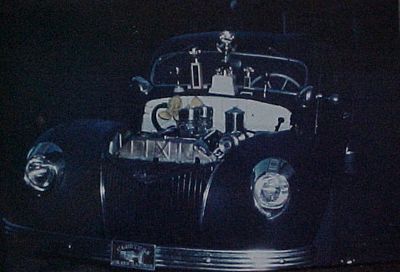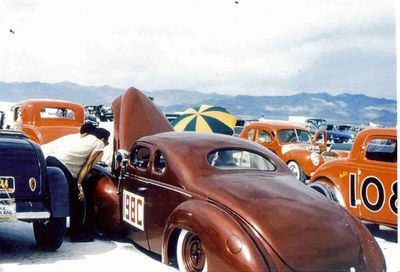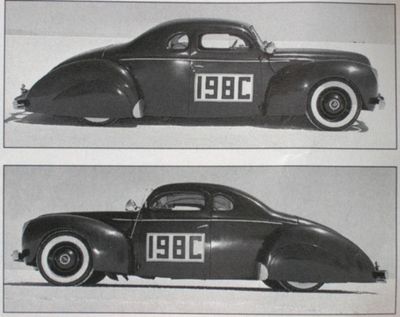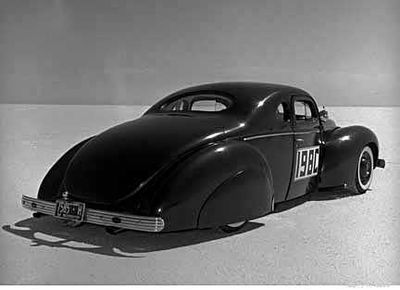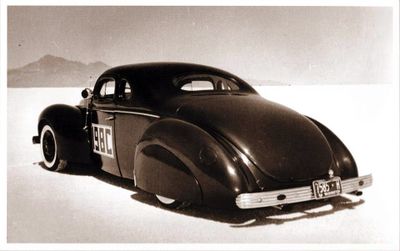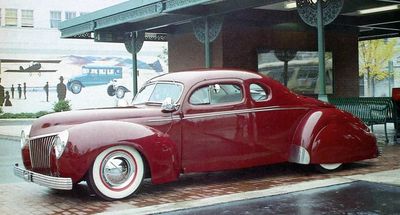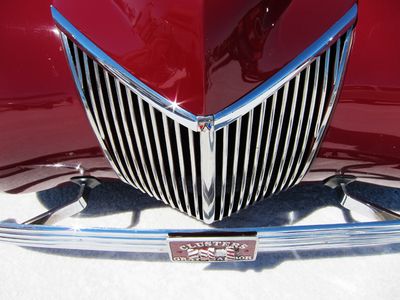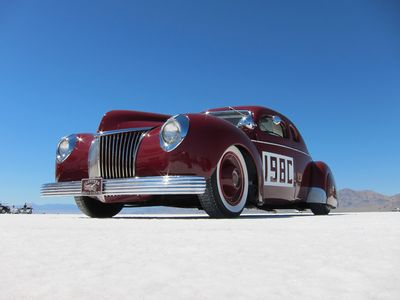Doug Rice's 1939 Ford




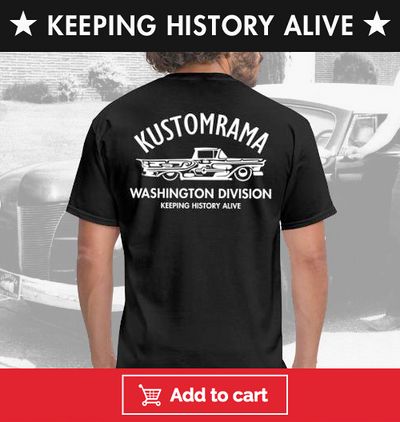


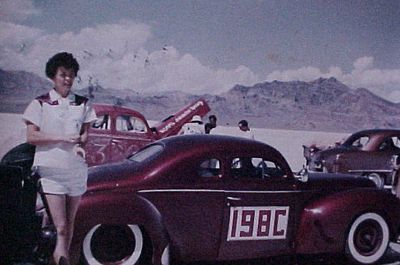


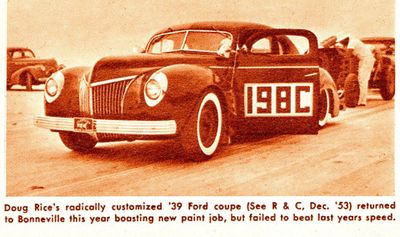


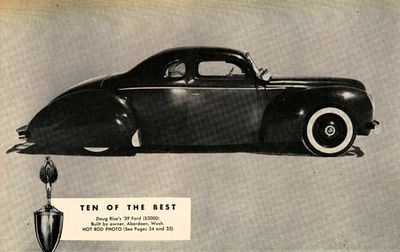




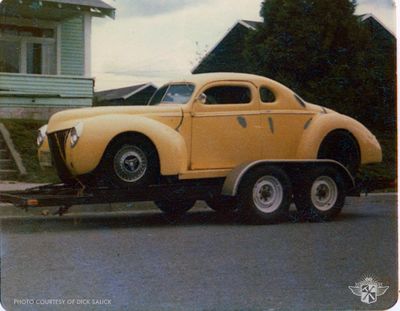



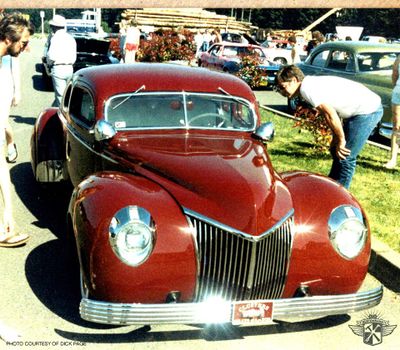
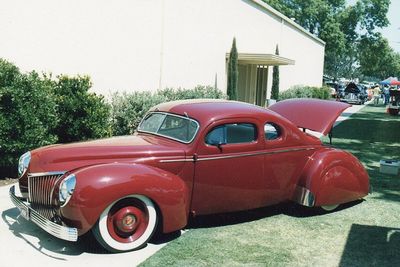

1939 Ford Coupe owned and restyled by Clusters of Grays Harbor member Doug Rice of Aberdeen, Washington. Doug did all of the work on the car himself, and the build was started while he was in the Navy, on a submarine in Hawaii. He bought the car around 1948, and began to modify it shortly after he got it. Doug built the first engine in the Navy yard workshop. He started by relieving the block. It was going to take a lot of grinding, so Doug started with a chisel til he was close enough to finish it off with a grinder.[4] After four years in the service, Doug was discharged from the Navy in 1951. The coupe was shipped from Pearl Harbor to San Francisco, California. He then drove the coupe to Aberdeen, where he continued to work on it.[5] Back home, Doug channeled the body about 5 1/2 inches. The channeling was easily done by just torching out a 1/8" steel plate to the contour of the frame. The steel plate was bolted onto the bottom frame flange with a rubber gasket to avoid noise, before the floor was torched open and the body dropped on to the steel plates. Doug kept the front fenders, grill and radiator in the stock position on the frame. The front fender openings were cut to match the curve of the tires and the openings were re-rolled by hand. Using a pencil tied to a string and the hubs as pivots, Doug plotted the new front wheel openings. A 1/4" rod was welded all around the opening for strength. After the body had been channeled over the frame, the rear fender had to be raised. This was done by maintaining the last bolt at the rear in its original position and by pivoting the front of the fenders up the desired amount, necessary to clear the 8.20x15 tires Doug ran. Doug felt that the rear fenders didn't look right when they were raised on the body, so he moved them out from the body as well by adding a two inch section of metal to their inner edges. This was done by torching off the stock fenders, leaving the mounting rim in the new position still on the car. Then another fender was welded to the rim. An extension was welded to the bottom of the front to maintain the original body line.[3] By doing this, Doug increased the width of the car by approximately 4 inches. After the body was channeled, Doug had to section the hood, firewall and the small front quarter panel. In the same operation, the hood seam was filled. The side chrome strip on the hood had to be shortened due to the raised fenders.[6] All body work was acetylene torch hammer welded before Doug went over with a pick hammer and a vixen file. Lead was added where needed and followed by more vixen fileing. According to Doug, no "spot putty" bondo was used, as that was a "no no" at the time. The front was lowered by installing a dropped axle and by turning the front main leaf of the spring upside down. By simply turning the main leaf upside down, Doug didn't have to re-roll the eyes.[3] The rear was not lowered by kicking up the frame, as a featured story on the car in Rod & Custom December 1953 stated. The rear end lowering was accomplished by reversing the main leaf, as done in front, and by installing longer shackles. Doug drove the first version of the car to the 1952 Bonneville Nationals. This version featured a channeled body and an unchopped top. Doug drove down with a semi race cam, as the Harman & Collins camshaft he intended to race had not arrived yet. When he arrived, he went over to Salt Lake City where he found a Weber F4 Dirt Cam. The swap found place in an alley behind a service station. Running the Weber cam and a Roemer distributor, Doug made a 120.68 mph run with the coupe on Bonneville in 1952. The coupe was Doug's only transportation, and he drove it every day during the rebuild. Home from work friday night, and back to work monday, even while he was channeling the body and chopping the top.[3] Every time there was a drag, at Aberdeen, Shelton, Bremerton, Arlington or Scappoose, Doug attended with the coupe.[4]
After returning from Bonneville in 1952, Doug restyled the coupe further. The top was chopped 3 inches at the front, and 4 1/2 inches at the rear. During the chop, the stock split rear window was replaced by a single piece rear window from a 1942 Ford.[7] 1940 Ford doors were also installed in order to get the wing windows not used on the 1939 Ford. Doug bought a totaled '40 for its doors, rear window and other parts. The top rear door-corners were rounded to soften the "line" look. As Doug hated the "squinty" look of the "normal" chopped top, he decided to shorten the quarter windows during the chop.[3] The deck lid was filled, and Doug installed 1937 DeSoto bumpers on the car. The rear lights on the car were removed and relocated to the bumper guards. The rear fender openings had a section welded in at the top part so the stock fenderskirts would cover the opening. After the top had been chopped, the seat springs were arched over the driveline to lower the seat springs to the floor. After the second restyling, Doug ran the car without a hood for a while. The car was still his only transportation, and he drove it every day.[3]
In 1953 Doug's coupe was featured in Rod & Custom December 1953. The story was made at the 1953 Bonneville Nationals where Doug's coupe turned in a top time of 126.58 mph running on methanol and 25% nitroglycerin in the "C" coupe class.[3] As Doug wanted his custom to go fast on the salt flats, he equipped it with a Halibrand quick change rear end center section before he returned to Bonneville for the 1953 meet. In order to accommodate the Halibrand center section, an arched Model A spring was used along with an adjustable spring perch crossmember that Doug built and installed.[3] During the long haul from Aberdeen to Bonneville the howl from the straight-cut gears made Doug wonder if the rear end was broken. Doug's coupe was powered by a 296 cu. in. flathead Ford V8 that he had crammed inside the reduced engine compartment. The block was bored, ported and relieved ,and the crank was stroked 3/8" over stock. Heads and the four carburetor manifold were made by Edelbrock. The carburetors were Stromberg 97s. Harman & Collins provided magneto ignition and a Sportsman grind crankshaft. Doug made the headers from scratch. Inside, Stewart-Warner gauges recorded all activities of the engine. The gauges were placed inside a reworked 1940 Ford dash panel that came from Doug's donor car. The steering wheel was taken from a newer Ford.[6]
In 1954 Doug returned to Utah for the Bonneville Nationals. By then the car had been painted Tahitian Red. Doug spent a full night shift sanding the car before he had to get paint on it and assemble all of the chrome hardware. After the coupe had been stripped down to bare metal, Doug brought it over to Paul McGill for primer. Doug intended to take his sweetheart Janet to the 1954 meet. Janet's mother told Janet she could not go with him unless they got married, so Doug and Janet tied the knot practically as they left for Bonneville by the way of Los Angeles for upholstery. Doug had already written Bill Gaylord and sent him drawings of what he wanted done in the car. According to the magazines, Gaylord's was the #1 upholstery shop at the time, so that was why Doug choose Gaylord to do his upholstery. Doug and Janet had a hotel about a block or so from Gaylord's shop. About 7:30 in the morning someone pounded on their hotel door yelling "Hey, what color you want the upholstery in this car?" Doug yelled back, "Go away! This is my honeymoon". It turned out that Bill had lost Doug's drawings, so they had to figure it all out again. Gaylord fit Doug's coupe with a red and white pleated and rolled Naugahyde interior. While the coupe was at Gaylord's shop, Doug and Janet bought a Barris Kustoms built 1932 Ford roadster from a guy in Los Angeles. Janet had a near-new Chevrolet at the time, but they decided to sell it and buy a '32 while they were in California. As the roadster had no top, Doug had Gaylord make a top for the roadster as well. The roadster had run at El Mirage at 131 mph, and it had no fuel pump. As you drove and power fell off, you had to use the hand pump. On the way over, when Doug got tired of following a slow driver, he decided to pass, and Janet had better to get on the gas too in order not to loose Doug out of sight. At the Bonneville Nationals, Doug's coupe gained the attention of the Hot Rod Magazine crew who featured the car in their December 1954 issue. In the story, the car was called the "Bonneville Boomer", a name that stuck to the car. The coupe turned only 121.45 at Bonneville in 1954. Doug and Janet knew they weren't going to break any records, so they were aiming for the best-appearing car and crew. Before they left, Janet's mother sewed up some shirts to match the car and the brand new upholstery. Even though they looked very good, the that award went to one of the bigger teams as well. In addition to the new upholstery and paint job, Doug had removed the bumper guards and overrider from the rear bumper on this version of the car. The taillights were now integrated into the rear bumper.[7] After Doug had integrated the taillights into the rear bumper, the cops told him his lights were too low, so Doug installed the tail and stoplight in the rear window instead. Doug may have had the first ever tail and stoplight in the rear window, and he got away with one light legally because the 39 was first sold in 1938, when one light was ok, and the title listed the car as a 1938 model. Returning to Washington from Bonneville, Doug towed the roadster behind the coupe. Near Boise, Idaho the engine in the coupe started making a hell of a noise. It turned out that the crankshaft had broke. Doug figured they could push the the coupe with the roadster into town. It went a lot better than they had expected, so they decided to push the coupe all the way to Aberdeen. Janet had no radio or steering in the roadster, only gas and brakes. Doug in the coupe had radio, windows, steering and brakes. Doug remembers that they got strange looks when they stopped for gas and filled up the back car.[3]
Doug continued to drag the coupe, and he even returned to Bonneville for the 1955 meet. In 1956 the coupe was shown at the 2nd annual Portland Roadster Show, by then Doug had painted it black.[1] Later on in 1956, Doug's coupe was voted as one of the ten best customs in Trend Book 122 Custom Cars 1956 Annual. As time went on, the coupe fit Doug and Janet's new life on their horse farm less by the day. They started going to horse shows every weekend, and Doug built a two-horse trailer that they would tow with the coupe. It was Doug's only car, and it started to get real used up. At a car show in the Aberdeen armory a guy came from Bellevue and bought the coupe for around $700 as Doug recalls.[3] According to Don Richardson, who bought the coupe in 1983, a machinist named Roy McKutcheon was the new owner of the car. Roy put running boards on the copue, painted it yellow, and reportedly drove it for another dozen years.[4]
In 1977 a friend of Dick Salick of Aberdeen, Washington bought Doug's old coupe from a man in Lynwood, Washington. Dick helped the friend tow the old custom back home to Aberdeen. At the time, the coupe was still yellow. Later on Terry Boyer of Montesano bought the car from Dick's friend.[8] Terry lived lived just around the corner from Doug Rice. The car was very rusty when Terry got it, so he had it chemically dipped. After the car had been dipped, Terry hired metal-shaper Al Swedberg to put the car right. As Terry's lost interest in the car, the old custom ended up in his cousins basement.[4] In 1983, Don Richardson of Richardson Custom Auto Body in Hoquiam, Washington purchased the coupe from Terry. The car was basically a pile of parts when Don bought it.[5] Eric Perkins helped Don load up the car and put it back together again. A few things had gone missing over the years, like the garnish moldings and the DeSoto bumpers. Luckily, a local guy had a pair of bumpers that he almost gave Don as he knew they were going on the historic coupe. The taillights were recreated by filling the ribbed profile into red acrylic sheet. At the time, old flatheads had a bad reputation amongst the hot rodders, so Don decided to install a 350 engine from a 1981 Chevrolet truck, along with a Turbo 350 from a 1977 Chevrolet Chevelle in the coupe. He also used the driveshaft from the Chevelle, who funny enough bolted right on. During the restoration, Don replaced the front fenders. The wheel openings on the new fenders were not cut up the way Doug had done it when he built the car. Don's version of the car was also lower in the front than Doug's version. Holcomb Upholstery of Aberdeen trimmed the car up closely to Gaylord's pattern.[4] Two years were spent restoring the coupe back to the way it appeared in 1954, and in 1985, the restored version of the coupe made its debut at the annual Salem NHRA event.[1] In a letter to Street Rodder magazine in 1986 Doug wrote that he regret that he sold the car.[5] Even though Don lived only about 10 miles from Doug, the two didn't know eachother. Don first visited Doug when he worked at Smith and Losli Sheetmetal, telling him that he had something he would see. After Doug had seen the coupe, he invited Don out to meet his wife Janet. At Doug and Janet's farm, Doug gave Don some old parts such as one of the spotlights and the helmet Doug raced with back in the days. He also gave Don the Hellings and Stellings filters from the '32 roadster. Later on Doug found the other spotlight on an old tractor. He sawed the spotlight off and gave it to Don and his wife as their wedding present.[4]
In 2010 Don drove the car over for the 62nd annual Bonneville Speed Week. By then the car had been changed back to the way it looked when it ran the salt flats at Bonneville in 1954. Later on in 2010 Doug's old coupe was hand picked to be part of the prestigious Customs Then and Now exhibit at the 2011 Grand National Roadster Show in Pomona, California, an elite gathering of the most historically significant customs in the world.
Magazine Features
Rod & Custom December 1953
Hot Rod Magazine December 1954
Rod & Custom December 1954
Trend Book 122 Custom Cars 1956 Annual
Street Rodder December 1988
Rod Action March 1990
Rod & Custom's Little Page Annual 2012
The Rodder's Journal Number Fifty Six
References
- ↑ 1.00 1.01 1.02 1.03 1.04 1.05 1.06 1.07 1.08 1.09 1.10 1.11 1.12 1.13 1.14 1.15 Richardson Custom Auto Body
- ↑ 2.00 2.01 2.02 2.03 2.04 2.05 2.06 2.07 2.08 2.09 2.10 2.11 2.12 Rik Hoving Custom Car Photo Archive
- ↑ 3.0 3.1 3.2 3.3 3.4 3.5 3.6 3.7 3.8 3.9 Doug Rice
- ↑ 4.0 4.1 4.2 4.3 4.4 4.5 Rod & Custom's Little Pages Annual 2012
- ↑ 5.0 5.1 5.2 The Hawk & Buzzard - Bonneville Boomer
- ↑ 6.0 6.1 Rod & Custom December 1953
- ↑ 7.0 7.1 Trend Book 122 Custom Cars 1956 Annual
- ↑ Dick Salick
Did you enjoy this article?
Kustomrama is an encyclopedia dedicated to preserve, share and protect traditional hot rod and custom car history from all over the world.
- Help us keep history alive. For as little as 2.99 USD a month you can become a monthly supporter. Click here to learn more.
- Subscribe to our free newsletter and receive regular updates and stories from Kustomrama.
- Do you know someone who would enjoy this article? Click here to forward it.
Can you help us make this article better?
Please get in touch with us at mail@kustomrama.com if you have additional information or photos to share about Doug Rice's 1939 Ford.
This article was made possible by:
SunTec Auto Glass - Auto Glass Services on Vintage and Classic Cars
Finding a replacement windshield, back or side glass can be a difficult task when restoring your vintage or custom classic car. It doesn't have to be though now with auto glass specialist companies like www.suntecautoglass.com. They can source OEM or OEM-equivalent glass for older makes/models; which will ensure a proper fit every time. Check them out for more details!
Do you want to see your company here? Click here for more info about how you can advertise your business on Kustomrama.


